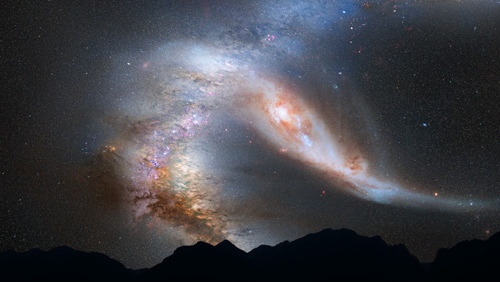“This photo illustration depicts a view of the night sky just before the predicted merger between our Milky Way galaxy and the neighboring Andromeda galaxy. About 3.75 billion years from now, Andromeda’s disk fills the field of view and its gravity begins to create tidal distortions in the Milky Way. The view is inspired by dynamical computer modeling of the future collision between the two galaxies. The two galaxies collide about 4 billion years from now and merge to form a single galaxy about 6 billion years from now.”
Four billon years from now, the Milky Way Galaxy, which we are located in, will collide with the neighboring Andromeda Galaxy. This is according to new research by NASA astronomers.
This collision will likely fling our solar system into a vastly different part of the Milky Way. The researchers say there is no danger of our solar system being destroyed in this collision though.
“Our findings are statistically consistent with a head-on collision between the Andromeda galaxy and our Milky Way galaxy,” said Roeland van der Marel of the Space Telescope Science Institute (STScI) in Baltimore.
The research was done using the Hubble Space Telescope. The Andromeda Galaxy is currently 2.5 million light years away but is being irreversibly drawn to the Milky Way through mutual gravitational attraction.
“After nearly a century of speculation about the future destiny of Andromeda and our Milky Way, we at last have a clear picture of how events will unfold over the coming billions of years,” said Sangmo Tony Sohn of STScI.
The researchers compare the collision to a batter in baseball watching a fastball come towards him — it will take some time but the trajectory is clear.
Computer simulations using Hubble’s data show that another 2 billion years after the first impact, the galaxies will completely merge into a single elliptical galaxy like the ones common in the local universe.
Although the galaxies will collide, the stars in them are so far apart that they will not collide. The orbits of stars around the galactic center will change though. Computer simulations suggest our solar system will be thrown much further from the galactic center than we are now.
The small galaxy that orbits Andromeda, the Triangulum Galaxy, will also join in the impact and possibly merge also. It may even impact first, before Andromeda.
“The universe is expanding and accelerating, and collisions between galaxies in close proximity to each other still happen because they are bound by the gravity of the dark matter surrounding them. The Hubble Space Telescope’s deep views of the universe show such encounters between galaxies were more common in the past when the universe was smaller.”
Only just a century ago, astronomers didn’t know that Andromeda was a separate galaxy. The vast distance between the two was ‘discovered’ by Edwin Hubble when he used a ‘variable star’ to serve as a measuring stick.
Andromeda is currently speeding towards the Earth at about 250,000 miles per hour. At that speed, you could reach the moon in an hour. This measurement was made by using the Doppler Effect, which is a change in frequency and wavelength of waves produced by a moving source relative to an observer.
“Previously, it was unknown whether the far-future encounter will be a miss, glancing blow, or head-on smashup. This depends on M31’s tangential motion. Until now, astronomers have not been able to measure M31’s sideways motion in the sky, despite attempts dating back more than a century. The Hubble Space Telescope team, led by van der Marel, conducted extraordinarily precise observations of the sideways motion of M31 that remove any doubt that it is destined to collide and merge with the Milky Way.”
“This was accomplished by repeatedly observing select regions of the galaxy over a five- to seven-year period,” said Jay Anderson of STScI.
“In the ‘worst-case-scenario’ simulation, M31 slams into the Milky Way head-on and the stars are all scattered into different orbits,” said team member Gurtina Besla of Columbia University in New York, N.Y. “The stellar populations of both galaxies are jostled, and the Milky Way loses its flattened pancake shape with most of the stars on nearly circular orbits. The galaxies’ cores merge, and the stars settle into randomized orbits to create an elliptical-shaped galaxy.”
The Hubble Space Telescope was recently upgraded with more powerful cameras. These upgrades have allowed these new calculations to be made.
The new research is set to be published in the Astrophysical Journal.
Source and Images: NASA’s Space Telescope Science Institute

i wish i could somehow live through all those years till THE END(the BEGINNING).
The TV says the galaxy’s are on a rubber balloon being stretched and racing apart. So how come a galaxy is going to crash into us? My IPad has an app with lots of galaxy’s smashing and crashing..what’s happened with the TV physicist and his balloon.
We, then, will have a next door alien people which we can go there for breakfast or coffee…ect. It is going to be fun.
this is so lame !!!! They cant even predict the weather with accuracy, And now Scientist’s think they can predict what is gonna happen 3.75 billion yrs from now ??? LOL Like gee I hope I’m around to see this awesome spectacle!!!
Some things are more predictable than the weather.
Asteroid and comet orbits are known hundreds of years in advance as seen from earth,watched a couple comets with the naked eye in the past 20years and it was cool!!!!
Come now, the standard model of the universe is in trouble, it has about 17 variables that need tweaking to predict anything. 85% of the universe is unknown “black” matter-energy, can anything be called a science where the so called scientists are becoming less knowledgable every year? The CERN has been a big disapointment, no Higgs Boson (god particle), No backing for strings, etc. The truth is that ignorance is advancing faster than knowledge.